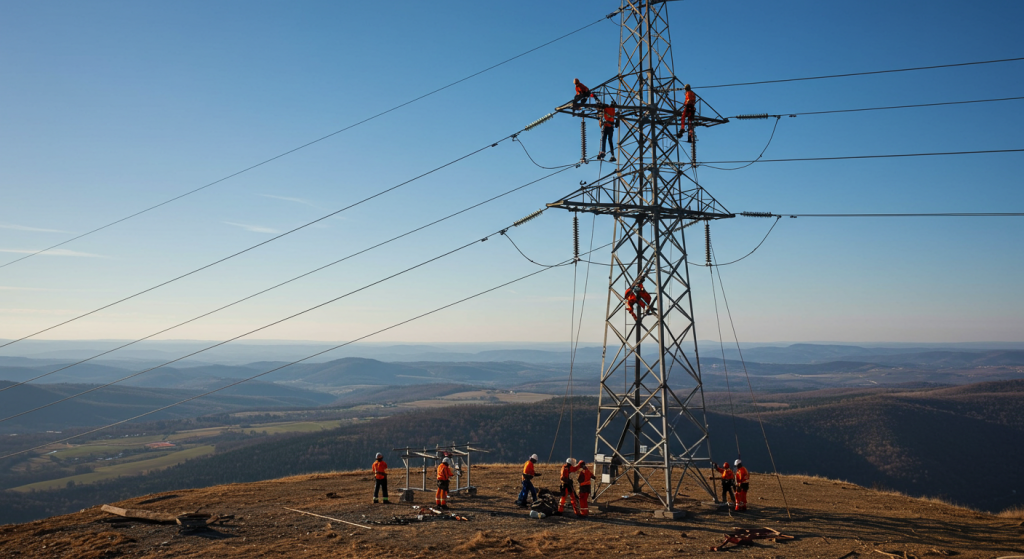Transmission Tower Maintenance: Procedures and Safety
2025-04-22
What is Transmission Tower Maintenance?
This refers to the systematic checking, repairing, and servicing of the physical structures that hold high-voltage power lines. Transmission tower maintenance includes both structural checks and corrosion checks while also assessing stress from the surrounding weather. The inspection includes both preventive maintenance (PM) and corrective maintenance. From vegetation removal to more detailed non-destructive testing (NDT), corrosion control, and live line maintenance, all tasks must be done optimally.
Types of Transmission Tower Maintenance
1. General Maintenance
The primary focus of general maintenance is ensuring the functionality and condition of the equipment and the structural condition of the tower. Includes:
• Overhead line maintenance entails checking, repairing, or removing wear and damage to power lines.
• The electrical components of the tower require regular checking, which is called electrical tower maintenance.
• Drones and thermographic cameras are very useful in performing tower inspection, which is a critical but less physically accessible aspect of the maintenance.
2. Specific Maintenance Activities
Identifiable actions aiding the maintenance of the tower and lines to protect the transmission system are what fall under specific activities.
• Tower cleaning: Regular cleaning prevents the accumulation of dirt, pollutants, and materials that can damage and stress tower components.
• Vegetation management: The clearing of vegetation in the easement ensures that power lines and storm and fire threats are not posed by plants.
• Corrosion control: A maintenance measure to address the deterioration of steel towers. Metal surfaces are safeguarded using paint, corrosion inhibitors, or other protective coatings.
• Component replacement: Insulators, conductors, and other hardware have to be periodically replaced to sustain the system’s integrity.
3. Inspection Technologies
The effective and safe maintenance of transmission towers is supported by modern technologies. Below are several examples:
• Infrared inspection: Enables the detection of problem areas, such as hotspots or thermal anomalies associated with conductor difficulties or insulator failure.
• Drone inspection (UAV): Vertical inspection of the drones is utilized, providing riskless access to high-quality images and videos of the tower.
• Thermographic inspection: The inspection of towers through the measurement of their temperature for discrepancies indicating the need for other corrective measures.
• Non-destructive testing (NDT): This technique is employed for assessing the structural integrity of components without inflicting any damage.

Key Issues Encountered in the Maintenance of Transmission Towers
1. Effects Of the Environment
The location of the tower is very relevant to the systematic maintenance and servicing of the tower. For example, maintenance regions include corrosion from coastal regions, frost damage from mountainous areas, and damaging storms. De-icing is often needed in cold regions to prevent damage from ice accumulation on towers and lines.
2. Risks Involved with Maintenance
The maintenance and servicing of high-voltage transmission towers pose great safety concerns. The exposure to electrocution while carrying out maintenance is a major concern that requires strict adherence to electrical safety measures. Power maintenance strategies are often used to deal with repairs without switching off the power supply, but this entails specialized training and equipment.
3. Maintenance Gaps in Corrosion and Structural Integrity.
Coastal and humid areas are highly susceptible to the risk of corroding transmission towers, and prevention strategies include periodic inspection and the application of anti-corrosion treatments like galvanization. In addition, structural defects such as welding complications or bolt loosening need timely attention to avoid the collapse of towers.
Transmission Tower Maintenance Best Practices
To maintain the transmission towers, there are a few practices that are crucial to ensure the infrastructure is reliable:
• Reliability-Centered Maintenance (RCM): This form of maintenance gives the most attention to components that are the most critical. It aims to reduce the failure rates as much as possible and streamline maintenance activity on towers.
• Condition maintenance (CBM): The maintenance is done according to the state of the equipment, which focuses on targeted repairs.
• Preventive maintenance: Regularly scheduled inspections and repairs to ensure that no major problems are present.
• Maintenance Scheduling and Planning: Proper scheduling ensures that the maintenance work is done on time so that no unnecessary downtime is experienced and no unscheduled repairs are needed.
Standards and Safety of The Tower
Safety measures are quintessential when it comes to working on transmission towers. Compliance with other legal and industry standards that govern the scope of maintenance is essential when it comes to safety. Some of the common aspects of safety are:
• Electrical safety - All work must ensure that no electrical accident is introduced during the maintenance.
• Tower Safety - The physical condition of the towers must be kept in such a manner that the workers performing maintenance are protected.
• High voltage safety - Work and materials must observe high voltage safety so that personnel and machines are protected from electrical risks and can perform safely.
Robotics and Artificial Intelligence in Tower Maintenance
The use of AI robotics applications and grid monitoring systems is automating the practice of performing maintenance on transmission towers. These technologies augment the capabilities of tower maintenance by automating inspections, repairs, and failure predictions with minimal human effort. The efficiency and safety of maintenance activities are enhanced with the use of drones for tower inspection and robotic arms for repair.
Advanced Techniques in Transmission Tower Maintenance
The advancements in transmission tower maintenance technology are paralleled by innovations in the energy sector. The future of maintenance work on transmission towers will be done through fully automated systems, more accurate diagnostic equipment, and advanced transmission monitoring systems that provide real-time information concerning the condition of the system.
Conclusion:
The effective and safe operation of power grids is sustained by transmission tower maintenance. With the application of modern technologies, regular inspections and timely repairs can ensure the systems' integrity and functionality are retained for years. Corrosion control, preventive maintenance, and other diverse approaches all contribute to safeguarding the long-term sustainability of these critical structures. Visit XY Tower.

Hey, I’m Chunjian Shu
"X.Y. Tower: Reliable, innovative solutions for high-quality towers and electrical equipment with professional service.
